Both crabgrass and quackgrass are invasive weeds. What is more, they grow fast. But they also have their differences.
What is the main difference between crabgrass vs quackgrass? First of all, crabgrass is a summer annual weed. So, it appears during spring and develops in the summer. Quackgrass has thicker leaves that are a little bit more coarse than the rest on the lawn. And it is a cool-season perennial, flourishing in the fall when everything else disappears.
Crabgrass VS Quackgrass
Let’s see some other differences in the following crabgrass vs quackgrass comparison.
Crabgrass
Crabgrass (Digitaria ischaemum) has an extensive root system coming out from the center of the plant. And while it is a common weed in most American lawns, it is native to Europe. In 1849, the U.S. Patent Office registered a patent for crabgrass as a crop for feeding livestock. Growers also used the edible seeds to make grain flour and couscous-like recipes.
This weed gets its name from the thick leaves and hairy leaf sheaths because they resemble a crab’s strong arm. More importantly, crabgrass can tolerate heat pretty well. This trait also helps this weed take over the lawn when the other plants go dormant in the fall as temperatures drop.
You might see a big patch of crabgrass on your lawn. Later in the winter, frost kills any trace of crabgrass. But when spring comes back, you still have that brown spot. Only that this time, the patch takes up more space. What happened? Once it gets cold, crabgrass dies and relies on the seeds left on the ground to sprout back up in the spring. In this case, crabgrass produced so many seeds that it grew in number. And now it is taking over your lawn.
How To Identify Crabgrass
As it matures, the weed grows out in a star pattern.
Even if you put down a pre-emergent, you might see crabgrass growing along the edges of sidewalks and less trafficked areas. So, you have to manually remove them from the ground before they produce any more seeds.
Its blades grow at a quicker pace than your good grass turf.
Mature leaves can develop roots on them as they keep growing outward.
The mature plant has light lime green blades. Usually, they are wide, about 1/4″—the size of a pencil.
Quackgrass
Quackgrass (Elymus repens) loves to come up in the middle of other plants. What is worse, it can propagate via seeds and rhizomes. So, digging around well is paramount when eradicating this weed.
Why is quackgrass so dangerous for your good grass? Its rhizomes create chemicals that stunt the growth of other plants. Besides, pulling out the underground runner without disturbing or damaging other plants’ roots is toilsome. If not impossible at all.
Underground runners make quackgrass harder to remove for good from your lawn. So, you have to deal with it as soon as you find it. Otherwise, it will only take this weed two or three years to suffocate everything else on the lawn.
Selective herbicides do not work on this weed. And while you could use a systemic herbicide, this method will kill all the other plants. So, eliminating the underground runners as often as possible by digging them out is critical for controlling this weed.
If you leave the underground roots, they will send up new green shoots. So, you cannot leave them be either.
How To Identify Quackgrass
A lawn full of quackgrass usually looks yellowish. Or it has yellow patches, with the only green ones being quackgrass.
Its stems are white and thick. Also, quackgrass grows in clusters. And near the base, you can see two ear-like leaves that sometimes peek out from the ground.
Quackgrass has thicker leaves than good turf blades. But unlike crabgrass, its leaves are not wider than regular grass.
The best period to spot quackgrass is late winter or early spring when other plants are still dormant. Plus, the ground is usually moist and easy to work with, which helps dig out the rhizomes.
The clasping auricles, the tiny parts of the leaves attached to the stem, hug around the central stem.
Crabgrass VS Quackgrass
In general, quackgrass is the most stubborn weed that can invade your lawn. But if you nip it in the bud and eradicate it early, you can prevent it from taking over your land.
On the other hand, crabgrass is prolific. Meaning it makes lots and lots of seeds. So, you could underestimate its threat because it does not impact your lawn until it is too late. After all, crabgrass replaces your good grass without many visible signs. Instead, as quackgrass takes over, your turf becomes yellow because it smothers the other roots.
Crabgrass VS Quackgrass: Conclusion
In the end, they are both horrible weeds that act as pests. But without any doubt, crabgrass is a little easier to manage. So the winner of the comparison Crabgrass VS Quackgrass as the most annoying, stubborn invasive plant would probably be quackgrass.
Related Article: When to Apply Crabgrass Preventer?



